
The New Zealand smooth skate is a skate of the genus Dipturus, found around New Zealand at depths between 15 and 1,300 m.
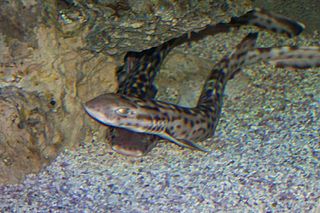
The coral catshark is a species of catshark in the family Scyliorhinidae. It is common on shallow coral reefs across the Indo-West Pacific, from Pakistan to New Guinea. Reaching up to 70 cm (28 in) in length, the coral catshark has an extremely slender body, a short head and tail, and two dorsal fins that are angled backwards. It can be identified by the numerous black and white spots on its back, sides, and fins, which often merge to form horizontal bars. Furthermore, adult males have distinctively long and thin claspers.

The brown shyshark or plain happy is a species of catshark, part of the family Scyliorhinidae. It is endemic to the shallow, coastal waters of South Africa from west of Cape Agulhas to KwaZulu-Natal. This benthic species is usually found over sandy or rocky bottoms. Measuring up to 73 cm (29 in) long, the brown shyshark is stoutly built, with a broad, flattened head and rounded snout. Unlike other shysharks, the brown shyshark has a plain brown color, though some individuals have faint "saddle" markings or light or dark spots. When threatened, this shark curls into a circle with its tail over its eyes, which is the origin of the name "shyshark". It feeds on bony fishes and lobsters, and is oviparous with females laying pairs of egg capsules. The International Union for Conservation of Nature (IUCN) has assessed this harmless species as Vulnerable. It is of no commercial or recreational interest, but its limited distribution makes its entire population vulnerable to increases in fishing pressure or habitat degradation.

The freckled catshark is a catshark of the family Scyliorhinidae. It is found on the continental shelf and upper slope from the western Atlantic from western Venezuela, Suriname, Brazil, and Uruguay, between latitudes 11° N and 32° S. However, specimens from the northern part of this range probably refer to other species.
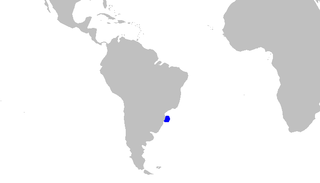
The southern sawtail catshark is a species of catshark, part of the family Scyliorhinidae, endemic to southern Brazil. It inhabits deepwater reefs on the upper continental slope at a depth of 236–600 m (774–1,969 ft). Reaching at least 43 cm (17 in) in length, this slim-bodied species closely resembles the Antilles catshark. It has a prominent crest of enlarged dermal denticles along the dorsal edge of the caudal fin, as well as a distinctive color pattern of dark oval blotches, outlined in white, along its back. The southern sawtail catshark is oviparous, with females producing reddish egg capsules. The International Union for Conservation of Nature (IUCN) has assessed it as Vulnerable; it is often taken as bycatch and may be threatened by intensifying squid fishing.

The spotback skate is a species of fish in the family Arhynchobatidae. It is found off the Atlantic coasts of Argentina, Brazil, and Uruguay where its natural habitat is over the continental shelf in the open sea. It is a large fish, growing to over a metre in length. It feeds mainly on other fish according to availability, with shrimps, octopuses and other invertebrates also being eaten. Reproduction takes place throughout most of the year, with the eggs being laid in capsules that adhere to the seabed. The spotback skate is the subject of a fishery and is thought to be overfished, resulting in Greenpeace adding the fish to its red list of fish to be avoided, and the International Union for Conservation of Nature listing it as an "endangered species".

The deepsea skate is a species of softnose skate, in the family Arhynchobatidae, found in deep water from 362 to 2,906 m, usually on the continental slope. They are distributed from off northern Baja California around Coronado Island and Cortes Bank, north to the Bering Sea, and west to Japan. There have also been sightings north of Darwin Island within the Galapagos Marine Reserve in 2015. This was the first record of the Deepsea Skate being found in the tropical eastern Pacific Ocean. It is fairly common below 1,000 m, and is taken as bycatch in deepwater trawls and traps. The species name abyssicola comes from the Greek abyssos meaning "bottomless", and cola meaning "living at depths".
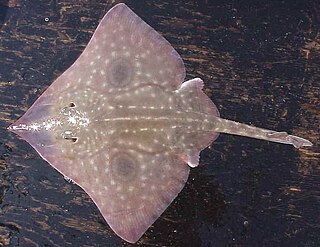
The big skate is the largest species of skate in the waters off North America. They are found along the Pacific Coast from Alaska to Baja California, typically from the intertidal zone to a depth of 120 m (390 ft), and feed on benthic invertebrates and small fishes. They are unusual among skates in that their egg cases may contain up to seven eggs each. This species is one of the most commercially important skates off California and is sold for food.

The bottlenose skate, spearnose skate, or white skate is a species of skate in the family Rajidae. It is a benthic fish native to the coastal eastern Atlantic Ocean. Due to overfishing, it has been depleted or extirpated in many parts of its former range in the northeastern Atlantic and the Mediterranean Sea, and is now endangered.
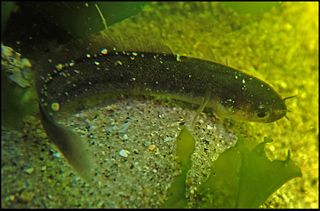
The fivebeard rockling is a coastal ray-finned fish of the family Lotidae. the lings and rocklings. It is found in the eastern Atlantic Ocean. It is not a fish of any commercial importance.

The thorny skate is a species of fish in the family Rajidae. This bottom-living skate lives in the North and south-eastern Atlantic Ocean in depths ranging from 20 to 1,000 m (66–3,281 ft) and water temperatures from −1 to 14 °C (30–57 °F).

The shagreen ray, also known as shagreen skate or fuller's ray, is a species of skate in the family Rajidae. This ray is found in the eastern Atlantic Ocean, from Murmansk, Russia through Norway, southern Iceland, the Faroe Islands, the Celtic Sea, the northern North Sea and Skagerrak, to western Morocco and the Madeira archipelago, but not in the shallow waters off England and Wales. It is also recorded sporadically in the Mediterranean Sea.

Lagodon is a genus of saltwater fish in the family Sparidae, the breams and porgies. It is monotypic, being represented by the single species Lagodon rhomboides, commonly known as pinfish. Other common names include pin perch, sand perch, choffer, and butterfish. It inhabits mostly subtropical shallow coastal waters of the Atlantic and Gulf coasts of the United States and Mexico.
The spotted dragonet is a species of dragonet native to the eastern Atlantic Ocean and the Mediterranean Sea where it occurs at depths of from 45 to 650 metres. This species is important to local peoples engaged in subsistence fishing.
Broadnose skate is a species of skate in the family Arhynchobatidae. This fish occurs on 28 to 604 meters, mostly at depths shallower than 250 meters, from Valdivia and Estrecho de Magallanes to Argentina and the Falkland Islands. It has the maximum total length of about 125 centimeters which it reaches in about 20 years. Both sexes reach maturity at age 8–10 years.

The graytail skate, or gray tail skate, is a large species of skate in the family Arhynchobatidae, native to the south-western Atlantic Ocean and south-eastern Pacific Ocean. It is listed as endangered by the IUCN. It was caught as part of a commercial fishery around the Falkland Islands and is a bycatch in several other fisheries.
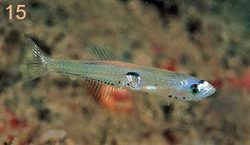
Crystallogobius linearis, the crystal goby, is a species of goby native to the Atlantic coasts of Europe and the Mediterranean Sea where it can be found at depths of from 1 to 400 metres. Males of this species grow to a length of 4.7 centimetres (1.9 in) SL while females only reach 3.9 centimetres (1.5 in) SL. This species is the only known member of its genus. The name Crystallogobius comes from the Latin words cristallum, meaning "crystal", and gobius, meaning gudgeon.
The Norwegian skate, or black skate, is a species of skate found at depths of 200 m (660 ft) to over 1,600 m (5,200 ft) in the East Atlantic region. Initially its range was believed to be restricted to the Norwegian Sea and North Sea to the Bay of Biscay. It is occasionally encountered off the western coast of Ireland, and historically has been found near Rockall and in the Norwegian Deep, though recent surveys have not identified the species there. The species has frequently been confused with other skates, and since the late 1980s it has been confirmed to occur more widely, ranging from Iceland to Morocco, as well as off South Africa and in the Mediterranean Sea.

Raja stellulata, commonly known as the Pacific starry skate, rock skate, prickly skate, or starry skate, is a species of cartilaginous fish in the family Rajidae. It is found on rocky bottoms at 18–982 m depths in the Northeast and Eastern Central Pacific, from Coronado Bank in northern Baja California in Mexico to Barkley Sound in British Columbia, Canada. Females reach a maximum total length of 76.1 cm and a maximum age of 15 years, while males can be up to 71.7 cm long and live up to 14 years; the total length at birth is 15.5–22.5 cm. This skate prefers cold water with a temperature of 4.1–11.6°C.

Doryrhamphus negrosensis, commonly known as Negros pipefish, flagtail pipefish, Masthead Island pipefish or Queensland flagtail pipefish, is a species of marine fish of the family Syngnathidae. It is found in the Western Pacific Ocean, from Borneo to Vanuatu and the Yaeyama Islands to the Rowley Shoals and the Great Barrier Reef. It lives in mud flats and reefs, both coral and rocky, where it is often associated with sea urchins. It is a rather solitary species which may be found in pairs or small groups. It inhabits depths to 9 metres (30 ft), and can grow to lengths of 6.2 centimetres (2.4 in). Although little is known of its feeding habits, it is expected to feed on harpacticoid copepods, gammarid shrimps, and mysids, similar to other pipefish, it may also act as a cleaner fish like other species in the genus Doryrhamphus. This species is ovoviviparous, with males carrying eggs before giving birth to live young. Males may brood at 4.3 cm. It is a small bluish to bluish-grey pipefish which has a pale stripe along the dorsal side of the head and snout, and a dark fan-like caudal fin which has white margins and an orange base.


















